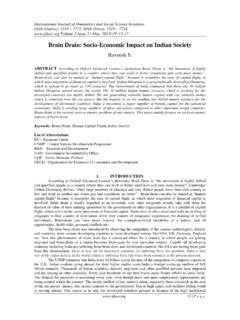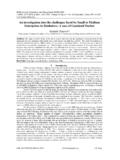Transcription of Challenges Faced by Schools when Introducing ICT in ...
1 International Journal of Humanities and Social Science Invention ISSN (Online): 2319 7722, ISSN (Print): 2319 7714 Volume 2 Issue 9 September. 2013 1 | P a g e Challenges Faced by Schools when Introducing ICT in Developing Countries NomsaMndzebele Department of Business Administration,/ University of Swaziland, Swaziland ABSTRACT: Although ICT has the potential to improve the education system of every country to a great extent but this is not the case in some of the developing countries because of certain Challenges . Technologies allow students to work more productively than in the past, but the teacher s role in technology is more demanding than before.
2 ICT has the potential to transform the nature of education but most developing countries face a number of Challenges . The aim of the study is to present a review of the state of ICT in the school system in a developing country, by evaluating the current use of ICT as well as the Challenges encountered when Introducing ICT in the classrooms. A qualitative and quantitative research was used to collect data. Systematic sampling was done on the Schools in terms of region, location (urban/rural) and type of school (government, mission/church, or community). KEYWORDS: education, Challenges , information communication technology, Schools , teaching I.
3 INTRODUCTION In order to compete in the global competitive economic environment, a highly skilled and educated workforce with aptitude and skill in the application of Information and Communication Technology (ICT) is essential [1]. It is important that all sectors of the education understand the benefits of investing in ICT and the infrastructure that is required for Introducing ICT. There is a need for government to partner with private sector for resource mobilisation to fund the use of ICT in education [2]. This calls for policies that promote broad access to skills and competencies to learn ICT [2], which can be achieved by providing broad based formal education, establishing incentives for firms and individuals to engage in continuous training.
4 The Network Readiness Index (NRI) index has four sub-indices namely environment, readiness, usage and impact. Currently Swaziland ranks no 136 out of 142 countries measured in NRI [3]. In the SADC sub region the only country ranking lower than Swaziland is Angola and countries like Lesotho, Zambia and zimbabwe have outranked Swaziland by creating an enabling environment for ICT to thrive and implement strategies that catalyse the industry. Swaziland s lowest scoring in sub-indexeswas readiness and impact. ICT readiness is the first process on the ICT development value chain. Thus the ICT ministry has come up with the implementation plan so as to improve the access, usage, economic and social impact [4].
5 The aim of the study is to present a review of the state of ICT in the school system in Swaziland as well as the Challenges encountered when Introducing ICT in the classrooms. In Africa, the introduction of computers into primary and secondary education is a recent phenomenon [5]. High subscription and ICT infrastructure costs coupled with the poor quality of service providers and the lack of basic infrastructure such as electricity can act as barriers to the use of ICT in education. What have helped the Schools to have computers are foreign donors and the companies that donate as a social responsibility project. Table 1 shows the total number of secondary/high Schools and Table 2 shows the Schools that had computers in 2012.
6 39% of the Schools were in the rural areas and 19 % in the urban [6]. It is in the MoE ICT policy that the emphasis on ICT be in the rural Schools . The computers range between 3 and 200 per primary school [6]. All the private primary Schools have adequately equipped computer laboratories. Challenges Faced by Schools when 2 | P a g e Table 1: Distribution of Schools Secondary/High Schools Type No % Community 172 Government 9 Private 21 Mission 51 Total 253 100 Total 253 100 MoE March School list 2012 Source: Report MoE/Jica October 2012 Table 2: Schools offering computer studies and curriculum Region Rural Schools Urban Schools curriculum Hhohho 21 17 IGCSE Lubombo 23 8 Manzini 27 17 Shiselweni 26 6 Total 98 48 Source.
7 MoE 2012 Of the 142 Schools with computers only 38 Schools wrote the International General Certificate of Secondary Education (IGCSE which is the UK grade 12 exam) exam in 2011 and 2012. Government has no set curriculum to be followed by secondary Schools on ICT subjects. A probable reason why the other Schools are not writing the IGCSE is the shortage of qualified ICT teachers in the Schools . A study was done in 2012 with a sample of 42 Schools that have ICT both in urban and rural. The study revealed that 34 % of the teachers teaching ICT are bachelor holders who are employed for other subjects such as mathematics, science, business, accounting, geography and agriculture etc.
8 Most of the 32% of the teachers who are employed on permanent basis to teach ICT are on transit, they are looking for jobs in the industry. Whilst there are calls for a new kind of learning in which students deal with knowledge in an active and self-directed way through use of computers and internet, it must be noted that the older technologies such as television play a significant role in education especially in least developing countries. Swaziland has just passed a bill on the ICT regulation and among the components in the bill is that there is going to be a channel on Swazi TV for teaching purposes. II. METHODOLOGY The study was descriptive and consisted of phase 1 and phase 2.
9 Phase 1 was a close ended questionnaire and phase 2 was interviews with all the education instituions in the country. The Schools that were used in phase 1 were drawn from the database of the MOE. The target population was Schools that have computers. The Schools were selected in terms of region, location( urban or rural) and type of school (government owned, mission owned or community school).Systematic sampling was used on the Schools in each of the four regions so as to have Schools represented in all the regions. A close ended questionnaire was administers to 42 high Schools that teach ICT. In phase 2 of the study , an interview as done with the institutions that offers education.
10 Phase two of the study was to find out the Challenges Faced by the institution in teaching ICT. Whiles phase 1 of the study was to get the Challenges Faced in the classroom. This was because the purpose of the study was to find out the Challenges Faced by the Schools when Introducing ICT in the classroom. III. Challenges Faced BY THE Schools WHEN Introducing ICT The government of Swaziland is committed in implementing ICT in the Schools however, the process in hindered by a number of barriers. [1] categorised the barriers into two sections; external and internal barriers. The first order barriers according to [8] include lack of equipment, unreliability of equipment, lack of technical support and other resource related issues.






